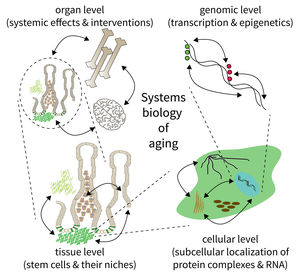Subarea 5: Computational and Systems Biology of Aging
Subarea 5 focuses on the development of methods to analyse and understand complex biological systems. This work includes the design of computer algorithms and biostatistical approaches as well as the development of novel Omic strategies (i.e. genomics/epigenomics, transcriptomics, proteomics, and metabolomics) to study aging and aging-related diseases. According to the FLI, due to the Subarea's expertise in computational data analysis, it is deeply interconnected with all other Subareas. The Subarea hosts two critical core facilities (Life Science Computing, Proteomics) and provides consulting services in statistics. Furthermore, it organizes courses on data analysis and statistics.
The research is defined by five focus areas:
- Mapping extrinsic and intrinsic factors influencing stem cells during aging,
- Integration of spatiotemporal proteomics and transcriptomics data,
- Comprehensive evaluation of qualitative and quantitative expression changes,
- Identification and analysis of epigenomic alterations during aging and age-related diseases, and
- Network analysis of genomic, transcriptomic and epigenomic alterations during aging.
Research focus of Subarea 5.
The biology of aging can be viewed as a multilayered array of networks at the level of organs, cells, molecules, and genes. The FLI wants to meet this complexity by establishing the new Subarea on “Computational and Systems Biology of Aging”. The overall goal is to interconnect research at different scales, taking place in Subareas 1-4 of the Institute’s research program. The new group on Systems Biology will integrate data from networks at multiple scales and will thus point to mechanisms and interactions that would not be seen in unilayer approaches.
Publications
(since 2016)
2021
- Extensive remodeling of the extracellular matrix during aging contributes to age-dependent impairments of muscle stem cell functionality.
Schüler SC, Kirkpatrick* JM, Schmidt* M, Santinha D, Koch P, Di Sanzo S, Cirri E, Hemberg M, Ori** A, von Maltzahn** J
Cell Rep 2021, 35(10), 109223 * equal contribution, ** co-senior authors - HAT cofactor TRRAP modulates microtubule dynamics via SP1 signaling to prevent neurodegeneration.
Tapias* A, Lázaro* D, Yin* BK, Rasa SMM, Krepelova A, Kelmer Sacramento E, Grigaravicius P, Koch P, Kirkpatrick J, Ori A, Neri F, Wang ZQ
Elife 2021, 10, e61531 * equal contribution - Loss of hepatic Mboat7 leads to liver fibrosis.
Thangapandi VR, Knittelfelder O, Brosch M, Patsenker E, Vvedenskaya O, Buch S, Hinz S, Hendricks A, Nati M, Herrmann A, Rekhade DR, Berg T, Matz-Soja M, Huse K, Klipp E, Pauling JK, Wodke JA, Miranda Ackerman J, Bonin Mv, Aigner E, Datz C, von Schönfels W, Nehring S, Zeissig S, Röcken C, Dahl A, Chavakis T, Stickel F, Shevchenko A, Schafmayer C, Hampe J, Subramanian P
Gut 2021, 70(5), 940-50 - Analysis, identification and visualization of subgroups in genomics.
Völkel* G, Laban* S, Fürstberger* A, Kühlwein SD, Ikonomi N, Hoffman TK, Brunner C, Neuberg DS, Gaidzik V, Döhner H, Kraus** JM, Kestler** HA
Brief Bioinform 2021, 22(3) * equal contribution, ** co-senior authors - Erratum to: Analysis, identification and visualization of subgroups in genomics.
Völkel* G, Laban* S, Fürstberger* A, Kühlwein* SD, Ikonomi* N, Hoffmann TK, Brunner C, Neuberg DS, Gaidzik V, Döhner H, Kraus** JM, Kestler** HA
Brief Bioinform 2021, 22(6) * equal contribution, ** co-corresponding authors - p63 and p53: Collaborative Partners or Dueling Rivals?
Woodstock DL, Sammons MA, Fischer M
Front Cell Dev Biol 2021, 9, 701986
2020
- Disruption of chromatin folding domains by somatic genomic rearrangements in human cancer.
Akdemir KC, Le VT, Chandran S, Li Y, Verhaak RG, Beroukhim R, Campbell PJ, Chin L, Dixon JR, Futreal PA, PCAWG Structural Variation Working Group, PCAWG Consortium
Nat Genet 2020, 52(3), 294-305 - The repertoire of mutational signatures in human cancer.
Alexandrov LB, Kim J, Haradhvala NJ, Huang MN, Tian Ng AW, Wu Y, Boot A, Covington KR, Gordenin DA, Bergstrom EN, Islam SMA, Lopez-Bigas N, Klimczak LJ, McPherson JR, Morganella S, Sabarinathan R, Wheeler DA, Mustonen V, PCAWG Mutational Signatures Working Group, Getz G, Rozen SG, Stratton MR, PCAWG Consortium
Nature 2020, 578(7793), 94-101 - Spatially resolved analysis of FFPE tissue proteomes by quantitative mass spectrometry.
Buczak K, Kirkpatrick JM, Truckenmueller F, Santinha D, Ferreira L, Roessler S, Singer S, Beck** M, Ori** A
Nat Protoc 2020, 15(9), 2956-79 ** co-corresponding authors - Pan-cancer analysis of whole genomes.
Campbell PJ, Getz G, Korbel Jea, ICGC/TCGA Pan-Cancer Analysis of Whole Genomes Consortium
Nature 2020, 578(7793), 82-93









